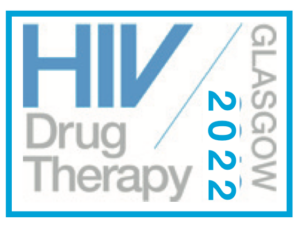Glasgow HIV Congress 2022
1 December 2022. Related: Conference reports, HIV 16 Glasgow 2022.
23–26 October 2022
Simon Collins, HIV i-Base
Introduction
 This year the HIV Glasgow Congress was held from 23–26 October 2022, overcoming the difficult challenges of being both an in-person and virtual meeting, at a time when organising medical conferences is especially difficult.
This year the HIV Glasgow Congress was held from 23–26 October 2022, overcoming the difficult challenges of being both an in-person and virtual meeting, at a time when organising medical conferences is especially difficult.
The planning and work involved to enable such meetings is often under-appreciated (and under-acknowledged) especially as they are now vulnerable to underlying shifts in COVID dynamics that are impossible to predict months beforehand.
And yet these meetings play a vital role in connecting us to the latest research and in generating new ideas and projects that only come from face-to-face conversations. As a comment, over recent years, an increasing number of delegates use their annual leave to attend and are self-financing.
The progamme is available online at the conference website:
https://www.hivglasgow.org
The abstract book is available as a supplement to the Journal of the IAS.
https://onlinelibrary.wiley.
As always, this meeting had a lively and very current programme.
Highlights from the oral sessions in this year’s programme include:
- The opening session rightly highlights the impact of the ongoing war against Ukraine and shows the resilience of doctors and other health workers both in Ukraine (for example, by continuing to develop and PrEP services) and in neighbouring countries that are supporting new migrants (in structuring emergency access to ART).
- Rethinking approaches to PEP based on efficacy data from PrEP.
- ART strategies, including same-day and very early ART.
- Studies that help to understand risk of virological failure with CAB-LA/RPV-LA despite perfect adherence to this long-acting injectable combination.
- Understanding mpox and the impact of different health responses to the recent outbreak.
- Changing patterns of pregnancies in women living with HIV in the UK, including the women who have lived with HIV since birth and are now becoming mothers.
- Patterns of comorbidities, including cardiovascular complications and especially as people living with HIV get older.
- The impact of SARS CoV-2 in people living with HIV.
- Durability of dual ART using dolutegravir and lamivudine.
- Updates on a reduced daily dose islatravir – now 0.25 mg/day – to enable research to continue in combination with daily doravirine.
- First virological data on the NIH-developed bNAb N6LSa, now being developed by ViiV as VH3810109.
Early reports from the meeting will be added to this page as they become available.
- Vertical transmission rate below 0.3% among women living with HIV in the UK
- Better re-suppression after viral rebound with DTG-based ART compared to EFV- or PI-based regimens
- Impact of islatravir on lymphocyte counts in a dose-ranging study: a post-hoc analysis
- Islatravir studies to use 0.25 mg daily dose to overcome risk of reducing CD4 and total lymphocytes
- Fostemsavir 240 week results from BRIGHTE study
- Fostemsavir: QT prolongation and drug-drug interactions
- Mpox updates on epidemiology, treatment and prevention
First published on 31 October 2022.

